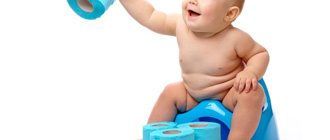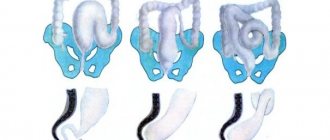Often young parents panic if they think that their baby is showing symptoms of diseases or pathological conditions. Constipation is one of the most common causes of concern among doctors. However, before diagnosing this condition in your child, you need to know the signs of its manifestation.
A big mistake that moms and dads make is self-medication, when, having heard about the newest drug for constipation in infants, the first thing they do is run to the pharmacy and buy a “miracle drug.” Also, you should not resort to traditional medicine methods, since they are usually suitable for adults or older children.
If new parents are really concerned about the baby’s health, then they need to not only be aware of the symptoms, but also consult a doctor in a timely manner. They will help establish an accurate diagnosis and prescribe adequate treatment.
What can signal the presence of constipation in a baby?
If a child does not poop normally for 2 days, this is a sign of constipation.
The most important thing to pay attention to is the presence of stool. If it is absent for 1.5-2 days, then this indicates constipation.
You also need to take into account the fact that in babies under 3 months the number of bowel movements normally reaches 2 to 4 times a day.
And upon reaching the age of 1 year, the number of bowel movements is reduced by half; 1-2 bowel movements per day is considered the norm.
It is very important for parents to know that infants and young children need to be given age-appropriate food. In babies, the intestines (like other organs and systems) are not sufficiently developed and are in the growth stage. Therefore, eating foods that are inappropriate for your age can lead to poor absorption and constipation.
If the child does not have bowel movements for 24 hours or the baby has difficulty defecating, this may indicate constipation. Usually, with proper nutrition, this problem is temporary and often goes away on its own.
How to help a child with colic?
1. A heating pad on the stomach. Heat is known to be an effective analgesic.
2. Pain relieving drops, with the doctor’s permission.
3. One of the effective ways to ease the period is massage for colic in newborns. It is advisable to do it not during attacks of pain, when the baby is all tense, but during quiet hours, for prevention. It is important that the baby’s stomach is relaxed, or at least not actively straining it. Through a very tense press, kneading the intestines is not achieved, so giving a screaming child a abdominal massage with colic is very problematic, especially for a mother who is not experienced in this matter. You have to catch quiet moments and massage.
What can a difficult bowel movement or its absence indicate in children under 1 year of age?
You should not self-medicate constipation in children under 1 year of age.
Separately, it is worth highlighting the age category of infants up to 2 months.
It is important for parents to know that if their children at this age experience difficulties with defecation, then under no circumstances should they resort to traditional medicine or self-medicate.
This behavior can only make the situation worse. The most correct decision would be to contact specialists, in particular pediatricians.
Abnormal bowel movements in infants can be caused by a number of reasons, which include:
- deficiency of breast milk in the mother, which can cause so-called “hunger constipation” in the child. In this case, all the nutrients entering the baby’s body are absorbed and there is simply nothing for him to excrete;
- allergy to goat's or cow's milk. It can be observed in children aged 3-3.5 months (and older) if they receive food in the form of porridge prepared with cow's or goat's milk. Some babies develop intolerance to proteins found in goat or cow milk, because they are, in principle, foreign. However, there are not many such cases;
- changing from one type of feeding to another. An example would be switching from breastfeeding to formula feeding, or changing the type or brand of formula;
- It is known that women are advised not to consume certain foods during breastfeeding. Violation of these rules may lead to constipation in the baby, since the body of an infant is very sensitive to the slightest changes in the mother’s body;
- introduction into the children's diet of products “not appropriate for age”, that is, those that are not yet recommended to be consumed during this period. If you start giving a product too early that is not intended for a specific age group, then this product will not be fully absorbed;
- colds and infectious diseases in a child, accompanied by hyperthermia (fever);
- insufficient fluid intake into the baby’s body. This is often observed during artificial feeding or during the introduction of complementary foods. Therefore, mothers must ensure that their children receive the required amount of fluid;
- lack of muscle tone in the intestines. This pathological condition is diagnosed only during a medical examination.
If the cause of constipation in a baby is found out, then following the instructions of doctors you need to eliminate the cause and at the same time fight constipation.
The process of normal release of processed nutrients by the body is extremely important, the health and well-being of the baby depends on it.
How often should I do it?
Pediatricians recommend giving your child massage in courses of ten procedures at three, six, nine and 12 months. The best time for massage is the first half of the day, an hour after feeding or an hour before it. Massage can be started from two to three weeks of age if the child is healthy and in a good mood. The room should have a comfortable temperature - 22-26°C.
If a mother gives a massage to a child, the baby calms down and tunes into a positive mood. How to give a massage to a three-month-old child so that he quickly begins to roll over onto his stomach and then sit down, how to massage the legs of a 12-month-old child so that he can walk faster - we will tell you more about this in this article.
What ways are there to help your baby cope with constipation?
Massaging your tummy is a good way to relieve constipation.
The most common way is to massage the tummy clockwise. Before the procedure, you need to wash your hands and warm them (if they are cool) so that the baby is comfortable enough.
Using smooth circular movements for 5-10 minutes, you need to move your palm over the baby’s tummy. The “bicycle” exercise is also useful for children with constipation.
To do this, the adult must carefully grasp the baby’s legs (ankles or feet) with both hands and imitate riding a bicycle in a circular motion.
How to properly massage the tummy of a newborn
Massage for gas formation in newborns
There are no rules, but there is a way to prevent them. What to do if your baby is prone to colic? Every parent knows that babies have colic, and they get very scared when the baby has the first attack. But when the fear, the desire to cry, the helplessness and the feeling that you cannot help your child have passed, it is time for a sober judgment - the child has developed colic, which may recur. Can this be fixed? You certainly can, but you must act before a problem arises. A way to combat colic is to massage your baby's tummy. Massage of a newborn with colic and gas is performed slowly and clockwise. It is enough to introduce a new, very pleasant ritual into your daily care.
Baby massage for constipation
Colic is nothing more than the inability to defecate. Every Adult knows what constipation is, so it's easy to imagine what your child is going through. An additional stress is the fact that the baby cannot express what he feels, in what place, colic or something else. Communication problems often lead to increasing frustration. The parent, to put it bluntly, does not understand why the baby is crying so terribly. The baby is bent over, his stomach is hard and tense, you may feel contractions, as if defecating, which, however, lead to nothing - you can be almost sure that this is what colic is approaching. This can be prevented by including fiber-rich foods in the diet, whether during breastfeeding or when expanding your baby's diet, and it is also worth giving newborn tummy massages for stool to help relieve tension in the abdomen and intestines. However, be sure to massage colic before it occurs—when your baby is already crying and upset, massaging a sore stomach can make him even more angry. Massage for constipation in a newborn infant must be carried out not only correctly, but in a timely manner. Of course, at such times it can also bring relief, but everyone knows that prevention is better than “cure”.
How to properly massage your baby's belly
First of all, believe that it works! Many parents do not trust natural methods of combating illnesses, and also want to quickly calm the baby, so they choose supplements or drugs. A well-executed tummy massage for a newborn from 0 not only helps prevent colic, but also brings a number of other benefits - closeness, relaxation for both parties, and the satisfaction of knowing that she can help her baby without special resources that are not always available. It is worth adding baby massage to your daily care rituals. A few minutes and a few simple movements are enough to have a beneficial effect on your tummy. Proper preparation is also important. Both Child and Parent should be relaxed and calm. Through touch, energy is transferred to the Child, so it is extremely important that the Parent is free from stress, takes his time and can spend time with the Child. The child should be deprived of the outer layers - he can remain in a bodysuit or even a diaper, and the room where he is being massaged should be a little warmer. The massage should not be performed “dry” - you need to lubricate the body with baby oil. You can use baby cosmetics, or you can also use regular olive oil, which also has a positive effect on the skin. If the massage is carried out in the evening, you can use a cosmetic product with a soothing, relaxing aroma that will help your child fall asleep.
Massage technique for colic in newborns
First, warm the olive oil in your hands. They should also be warm to make the touch as comfortable and pleasant as possible. The location of the massage is also important - it can be a changing table, firmly leaning against furniture or lying on the floor, or any other place convenient for parents and child. It is worth placing a flannel diaper, oilcloth or towel under the baby - a relaxed baby can arrange a “surprise”. Remember not to massage immediately after eating or when your child clearly does not want to do it.
How to give a gas massage to a newborn using the “mill wheel” method
First of all, calmly, but firmly, with light pressure. Each parent will feel what pressure he can afford, and the baby will make it clear what suits him best. The direction of massaging the tummy should be clockwise. In order for visceral abdominal massage for a baby to be effective, it is necessary to change the direction of hand movement. You can start with a vertical movement, placing your palms on top of each other, from top to bottom of your stomach, with light pressure, repeating the movement several times. This is called a mill wheel. The touch should be continuous and give off a light, pleasant warmth. You can then lift your baby's legs and bend them towards your stomach, but not too much. If the baby doesn’t like this, he has a kind of blockade; by bending his legs, you can put your hand on his tummy and press lightly - then he will be able to relax and willingly obey the parent’s movements. Usually, during such movements, the child releases gases, which is the first sign of proper massage. After such movements, you can further relax the baby - shake him slightly, hold him by the legs and even tickle him. Then you can return to the abdominal massage, but this time using circular movements (the so-called moon and sun) - a semicircle is made, starting from the right side of the abdomen from 12.00 to 6.00, and then with the other hand from 12.00 to 6.00, closing the circle. Then you can repeat pulling your legs towards your tummy. Each movement at individual stages of the massage should be repeated about 6 times. Finally, you can turn the massage into light, soothing touch, hugs, kisses of the little body.
How often can you massage a newborn?
Massage is performed every day. During the day, if it is not possible to massage under the right conditions, you can also carry your baby with light pressure on the tummy. You should then place your baby's stomach on your shoulder (as if he were hanging over your shoulder) and lightly massage his buttocks and back.
Baby massage for constipation, performed prophylactically, can prevent unpleasant moments full of pain and crying, tiring both parties. Such situations, full of tension and difficult emotions, are not needed by either children or their parents. Satisfaction of both parties is guaranteed!
What to do if the methods described above for dealing with constipation in infants do not help?
Glycerin suppositories are the best way to overcome constipation.
In this case, you can resort to so-called mechanical influences. These include:
- using a piece of soap and a cotton swab, which are carefully inserted into the baby’s anus. Before this, the stick needs to be lubricated with baby cream. Sometimes stimulation is caused by the inserted tip of a thermometer. However, special and quite convenient tubes for removing gases have now been created, which have become an alternative to existing methods.
- For babies under 1 year of age (and not only) you can use glycerin suppositories, which are inserted into the rectum. This method is quite effective;
- Today there are special mixtures for infants that help relieve them of constipation. But before using these mixtures, it is better to consult a pediatrician;
- If all of the above methods of dealing with constipation do not produce results, then you should resort to an enema. For infants, syringes with a capacity of up to 30 ml are sold. It is necessary to prepare clean water at room temperature and fill the syringe with it. You can also take a light chamomile solution. Then carefully lubricate the baby's anus area with baby cream and insert the tip of the syringe 1.5 cm. After this, you need to press on the enema so that the water from it passes into the intestines. For babies from 1 to 3 months, a single infusion is usually sufficient;
- If all of the above methods do not have the desired effect, you must seek qualified medical help. Doctors will help establish an accurate diagnosis, conduct a more in-depth examination and prescribe appropriate treatment.
How to massage a child's head and neck?
This type of massage is not recommended for children in the first months of life, and even when the child grows up, it is better to have a head massage performed by a specialist. If you want to do this massage yourself, massage your baby's head and neck with very gentle movements, as if you were lathering them with shampoo.
There are different methods of studying techniques for giving massage to children: video lessons, observing the work of a massage therapist, viewing diagrams and drawings in brochures on the development of a baby in the first year of life. But if, after studying the issue, you still have doubts about how to massage your child’s feet or how to massage his back, and also if your baby requires a course of professional corrective massage, you need to seek help from specialists.
Contraindications to massage
There are quite a few contraindications to medical massage. Absolute contraindications include the following diseases:
- malignant formations;
- dermatological diseases: herpes, lichen, pyoderma, etc.;
- acute cerebrovascular accidents;
- myocardial infarction;
- epilepsy;
- purulent inflammation;
- bleeding disorders;
- thrombophlebitis;
- recent bleeding;
- phlebeurysm;
- aneurysms;
- atherosclerosis.
Relative or temporary contraindications include fever, increased body temperature, respiratory diseases, and pregnancy. In case of peptic ulcer disease, it is important to achieve scarring; you can resort to massage only during exacerbations. After undergoing surgical interventions, it is important to wait a certain time; the doctor will tell you when you can go for a massage course.
Rules for preparing and performing massage
In order for massage for diseases of the digestive system to help achieve the desired results, it is important to adhere to several rules:
- take a shower before starting the session - it is important that the skin is clean;
- massage is performed at least 60–90 minutes after eating. When directly affecting the abdominal area, you need to increase the interval to 120 minutes;
- after a massage session, you need to lie down for at least a few minutes, it is better to eat food no earlier than half an hour later;
- During the procedure, it is necessary to relax the muscles as much as possible. The session may be accompanied by minor discomfort, but try not to strain your muscles;
- If you experience severe pain, notify your specialist.
A massage session should be carried out in a comfortable environment. It should only be performed by a qualified specialist - a massage therapist with a secondary or higher medical education. When choosing a massage therapist, make sure he has the appropriate training and also talk about his general health. A good specialist practices proven techniques and techniques, combining them with an individual approach: he will take into account the medical history, complaints, manifestations of disorders.
Remember that therapeutic massage for digestion involves a course of treatment. There will not be impressive results from one session - on average, 10-15 procedures are required to obtain the desired effect and improve digestive function, as well as general well-being. If you were forced to interrupt the course, discuss further steps with your doctor. In most cases, it is recommended to start the course again, it all depends on how long the forced break was.
The frequency of procedures is determined by the doctor individually depending on the nature and extent of the disease. Hygienic massage can be performed daily, while therapeutic massage can be performed twice a week.











